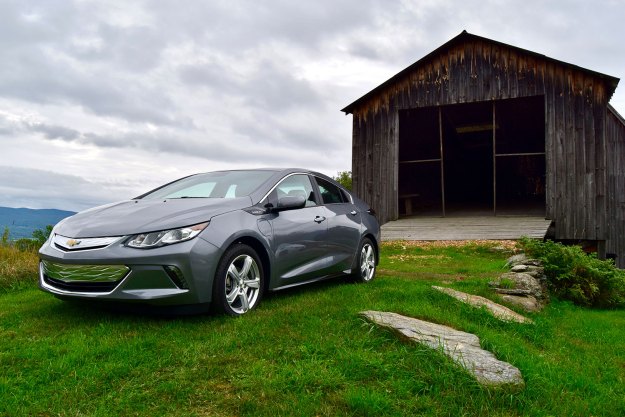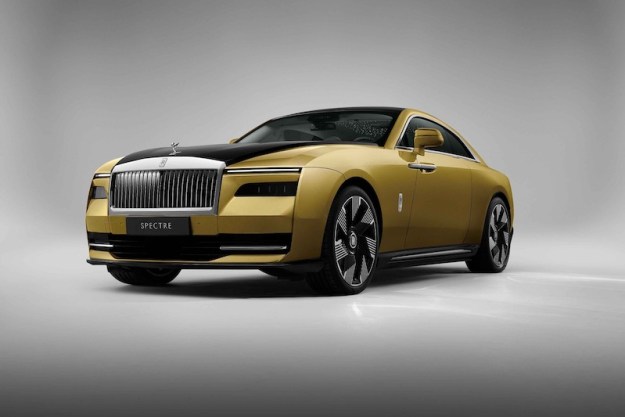
“The Chevrolet Volt is a no-compromise plug-in hybrid that is more than just a green car.”
- Best-in-class electric range
- Impressive overall range
- Surprisingly good driving dynamics
- Large, easy-to-use infotainment screen
- Lackluster efficiency on gasoline
- Cramped rear seats; not really a five-seater
- Dull material quality
- Down on cargo space
In the realm of traditional automakers, Chevrolet has really asserted itself as the prime candidate to take the fight to trendsetters and smaller companies with electrified vehicles. Yes, the Bolt EV is the vehicle that immediately comes to mind when the conversation turns to cars that don’t require gas. But Chevy also sells something that will help you slowly wean off of fuel if you’re afraid of jumping right into the electric car pool. That vehicle is the Chevrolet Volt, and it’s a plug-in hybrid.
As a plug-in hybrid, the Volt is capable of running on electricity for a certain distance, but also comes with a generator, which is technically a gasoline engine, for extra range when the battery is drained. When the time comes to fill up the battery, plugging into a charger will do the trick, just like an electric vehicle. With the Volt, Chevrolet was clearly looking to make a fuel-efficient vehicle that combined the best parts of a hybrid and an electric car. What it actually did was come out with a vehicle that manages to be a great overall package without relying on its green capabilities as a crutch.
The Chevrolet Volt is the American automaker’s sole plug-in hybrid offering. It has been around since 2010 and has been in its second generation since 2016. The 2019 model year sees many changes for the Volt, which benefits from a mix of new technology features that makes it a better electrified vehicle and some comfort ones that make it easier to live with. Major additions include a 7.2-kW charging system that, when hooked up to a 240-volt, level two charger can give the Volt a full recharge in 2.3 hours, which twice as fast as before, and the automaker’s new Infotainment 3 system that adds an 8.0-inch touchscreen.
As Chevrolet’s gateway vehicle into the world of electrification, the Volt is cheaper than its fully-electric sibling, the Bolt, with a price tag of $34,395 (including destination). The tester we piloted in Vermont was an entry-level LT trim finished in the optional shade of cajun red tincoat ($395) and came with the power convenience package ($1,660), the LT driver confidence package ($790), and the 7.2-kW charger ($750). Pricing for our well-equipped LT trim tipped the scale at $37,990. If you want more luxury with your efficiency, there’s also the Volt Premier that starts at $38,995 and that comes with the 7.2-kW charger as standard.
The plug-in hybrid segment continues to expand and the Volt now faces competition from the Toyota Prius Prime, Hyundai Ioniq Plug-in Hybrid, Kia Niro, and Honda Clarity. Just like the Volt, these competitors can travel on both electricity and gasoline. They can also be plugged into an electric charger. All of the aforementioned competitors, besides the Niro, which is more of a crossover, are likely options to be cross-shopped against the Volt as they offer a practical hatch.
Interior and tech
A lot of automakers have decided to take a more creative approach to the interior design of their plug-in hybrids – the vehicles are, after all, futuristic compared to vehicles that are solely powered by a combustion engine. Chevrolet’s designers took a more regular, car-like approach to the cabin that puts functionality before style and comfort. While hard plastics and low-end materials are hidden out of sight for the most part, the buttons and switches feel cheap. The silver trim that follows the curvature of the dashboard and the blue design element on the shift knob are especially garish.
Without going overboard to sound like we’re embellishing, the screen’s pretty, easy to use, well sized, and responsive.
While the center stack may appear confusing at first, the buttons are logically placed and, within 30 minutes of driving, finding where the button to turn the heated seats off is second nature – hey, the first day of fall may have just passed, but it already felt chilly in Vermont. The front seats are also comfortable and the new addition of a power driver’s seat with the available power convenience package, a first for the Volt (the seat is standard on the Premier trim), helps you get into a comfortable position for the long haul. The new addition of a driver-switchable adaptive cruise control system that provides the option of choosing whether the Volt follows a car or operates in a conventional manner, is also something that makes it easier to cover miles.
Where things start to go amiss for the Volt is when it comes to space in the back and cargo capacity. Because of the lengthy positioning of the battery tunnel and the rear set of cupholders, the passenger that draws the short straw and gets stuck sitting in the middle is in for a rough time. Even for those that end up getting the ability to sit in one of the full seats, the back is a cramped place to be. It’s the same case for cargo capacity, as the Volt only has 10.6 cubic feet of cargo volume. Competitors like the Clarity, Prius Prime, and Ioniq Plug-in Hybrid all have larger cargo areas, with Hyundai’s option being the most spacious, offering 23 cubic feet of cargo volume.
The saving grace for the Volt is its gorgeous 8.0-inch touchscreen display that features Chevrolet’s latest Infotainment 3 system. Without going overboard to sound like we’re embellishing, the screen is pretty, easy to use, well sized, and responsive. Everything is well laid out and getting Apple CarPlay or Android Auto up and running is a breeze. Thanks to a new energy app, you can clearly see things that are negatively affecting your fuel economy like terrain, driving technique, climate settings, and outside temperature. The instrument cluster has been updated, too, now sharing a design with the Bolt. Both screens have a video game-like interface that makes them attractive and simple to digest.
Despite having a plug-in hybrid powertrain, the Volt handles and drives like a regular vehicle.
In addition to the 8.0-inch touchscreen, the LT trim we tested came with two USB ports, OnStar, 4G LTE a Wi-Fi hotspot, a digital rear-view camera (new – and mandatory – for 2019), two 12-volt power outlets, and remote keyless entry. If you move up to the Premier trim, you’re rewarded with an eight-speaker Bose audio system, an auto-dimming rearview mirror, automatic park assist, and a wireless charging pad as standard.
Chevrolet offers all sorts of high-tech safety features on the Volt, but they’re predominantly available as options. Functions like lane change alert with side blind zone alert, lane keeping assist with lane departure warning, low speed forward automatic braking, and rear cross traffic alert are all optional. It’s important to note that some competitors offer these features as standard on their plug-in hybrid models.
Driving experience
Despite having a plug-in hybrid powertrain, the Volt handles and drives like a regular vehicle. That’s high praise for something that’s been engineered with fuel efficiency in mind. Unlike other plug-in hybrids, the Volt is pre-programmed to use up its electric range first, no matter how hard you jam your foot into the gas pedal. The only way to get the 1.5-liter four-cylinder engine at the front of the hatchback to kick in without depleting the battery is to engage hold mode, which is one of four that’s offered, the others being normal, sport, and mountain. Not that it matters, because the electric part of the Volt’s recipe is more than adequate.

The Volt’s drivetrain consists of an 18.4-kWh battery pack connected to two electric motors, as well as the gasoline engine. Combined output for the system stands at 149 horsepower and 294 pound-feet of torque, which is good enough to get the plug-in hybrid to 60 mph in 8.4 seconds.
When running on electricity, the Volt has a class-leading 53 miles of range. There’s no wink-wink yeah that’s 53 miles on a good day, either. Our first stop on Chevrolet’s press trip in Vermont included a visit to a dairy farm, which was well out of the way. To get there, we had to take a quick blast on the highway, which isn’t exactly a place where electric vehicles shine, traverse steep hills, and drive through windy sections. A good set of curvy roads usually has us digging deeper into the throttle, regardless of what the machine is really intended for. Even so, we managed to complete the roughly 40-mile trip without awakening the gasoline engine – impressive considering the terrain and our lack of a light foot.
With the Volt, you can say goodbye to both range and charging anxiety.
The trip computer indicated we had achieved 250 mpg for that trip. But that’s mpg and not MPGe. Chevrolet told us that we could get an actual figure of our real-world fuel economy by messing through the system, but after trying for a while, we couldn’t figure it out, so take that number with a boulder-sized salt tablet. According to the EPA, the Volt can get up to 106 MPGe.
The way the Volt handled turns was also surprising. Calling the vehicle sporty or athletic wouldn’t be correct, but enjoyable and fun are, especially when considering the fact that it’s not supposed to be a canyon carver. There’s little body roll and the chassis has a solid feel to it. The efficiency-oriented tires understandably undermine any attempt to have a good time behind the wheel of the Volt.
While the way the Volt can take corners is impressive for a green machine, the trade-off comes with its ride – it’s much stiffer than we imagined. Vermont’s roads aren’t the smoothest, and the Volt really lets you know that. Even small bumps were translated through the stiff suspension setup. It’s not jostling or uncomfortable, but noticeable, especially for plug-in hybrids, which are usually tuned for comfort.

Driving away from the farm and putting on our grown-up shoes brought out another side of the Volt, one that revealed just how green it was. Shifting the car into its low mode brings about stronger regenerative braking. We found that it was good for roughly 30 kWs of regeneration on its own. Using the steering wheel-mounted paddle, which has been updated for more aggressive regeneration, adds another 23 kWs of regen. Together, you’re looking at approximately 53 kWs of regeneration under hard braking.
The revised low driving profile also aids in one-pedal braking, something that Chevrolet really coined with the Bolt. Shift the gearbox into low and the plug-in hybrid will naturally coast to a stop without the need to use the brake pedal. It’s a little unnerving at first, but once you get the hang of it and start to anticipate stopping distances, regenerating kilowatts becomes second nature.
After the electric range is all gone, the 1.5-liter four-cylinder engine at the front kicks on without much notice. The Volt’s cabin is awfully quiet, and the transition from electricity to gasoline is so smooth that you really have to be listening for the engine. Performance when the gas engine is operating is similar to when the vehicle is running on its batteries. And the gasoline engine is impressively efficient, as well. On our next 35-mile leg, we managed to get 49 mpg. That’s better than the EPA’s estimation of 42 mpg combined. Even when running on gas, the Volt ensures that you’re getting around in a green way.
Before heading to the airport, we plugged our Volt into a level two charger for about an hour and a half. During that time, the plug-in hybrid managed to get half of its range back, allowing us to make the 25-mile trip to the airport on electricity. Yes, the Volt’s 53-mile range is impressive, but being able to get 25 miles back in less than two hours was even more spectacular. Goodbye range and charging anxiety.
Warranty
The Volt is backed by Chevrolet’s standard three-year/36,000-mile limited warranty and five-year/60,000-mile powertrain warranty, which is also the same length as the 24-hour roadside assistance program. The plug-in hybrid’s battery and electric components are covered for eight years/100,000 miles. J.D. Power gave the Volt a reliability rating of 70 out of a total of 100 points. That’s below the segment average score of 80 points.
How DT would configure this car
Chevrolet let us drive a well-equipped LT trim, which we found to be great for daily use. The LT comes with a decent amount of features, and since the Volt is already more expensive than the majority of its competition, going with the base trim is a good move. The power convenience package ($1,660) adds some things that make the Volt more comfortable for daily use, including heated front seats, heated exterior mirrors, a heated steering wheel, and a six-way power driver’s seat, so we’d get that package on our Volt.
Ticking the box for the LT driver confidence package ($790) brings some safety features, like rear park assist, rear cross traffic alert, and lane change alert with side blind zone alert to the Volt, a necessity if you ask us. Lastly, the 7.2-kW ($750) on-board charger is also a must, especially if you have access to a level two, 240-volt charger.
Our Take
The Volt may be a relative newcomer to the segment, especially as Toyota has been perfecting the Prius for over 20 years now, but the plug-in hybrid manages to be a great car that surpasses its green shadow. Chevy’s Volt isn’t just a good plug-in hybrid, it’s a good car, which is saying a lot at a time when automakers are still figuring out the ideal equation for fuel-efficient cars that need to be efficient, comfortable, usable, and affordable. With 53 miles of electric-only range and an extra 367 miles on gas after that, the Volt lets you have your cake and eat it too, as long as it’s for a four-person party.
Since the second-gen Volt came out in 2016, it has been the option to beat. It’s at the top of the plug-in hybrid charts as the benchmark. The changes for 2019, mainly the addition of the 7.2-kW charger that cuts charging time for the hatchback by half on a level two charger, not only solidifies the Volt’s role as the leader in the plug-in hybrid segment, but also makes it an excellent option if you’re curious about electrified vehicles. With the Volt, you don’t have to worry about range anxiety, you can go wherever, whenever. And with the new charging system, you don’t have to plan your stops or spend an entire day charging.

That doesn’t mean the Volt is faultless, as its cramped interior could be a no-go for some. If seating five and being able to carry a large amount of cargo is what you’re really looking for, the Kia Niro PHEV is a better option, as are the Honda Clarity, Prius Prime, and Hyundai Ioniq Plug-in Hybrid. None of those can match the Volt’s 53-mile range so you’ll have to compromise there. The closest competitor when it comes to range is the Clarity, which can travel 48 miles on electricity.
Another issue with the Volt is its price. The base LT trim costs $34,395 including destination. Every aforementioned competitor is more affordable than the Volt. The cheapest option, the Ioniq Plug-in Hybrid starts at $25,835, which is $8,560 less than the Volt. There’s also some bad news for the Volt when it comes to standard features, as even the Ioniq Plug-in Hybrid comes with things like heated front seats, heated exterior mirrors, and dual-zone automatic climate control as standard. Those are all optional on the Volt.
Should you get one?
Yes, absolutely. It doesn’t matter if you’re in need of a daily driver or a third car, if fuel efficiency via an electric vehicle is what you’re after, there’s so much that the Volt gets right that it’s worth the relatively large price tag. With more electric range than a lot of its competitors, the Volt really emphasizes the electric part of the plug-in hybrid equation while giving you the freedom of a hybrid. It delivers the best of both worlds while being comfortable and fun to drive in addition to being efficient.
Editors' Recommendations
- 2024 Chevrolet Equinox EV: price, release date, range, and more
- Tesla shows off first Cybertruck after two years of delays
- 2024 Mercedes-AMG S63 E Performance first drive review: high-performance plug-in
- Hyundai Ioniq 6 first drive review: welcome to the future
- Kia EV6 GT first-drive review: putting a little more fun into EVs












